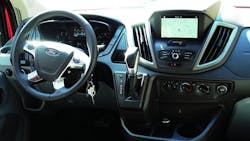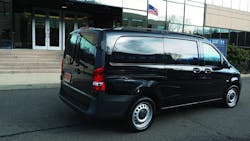What are some of the latest trends in light trucks—generally, Classes 1-3—in fleet-ready commercial vehicle offerings? First off, the fact that gasoline and diesel have both averaged less than $3/gal. for more than 18 months has gotten more Americans thinking light trucks again, according to industry execs, and it’s helping the segment boost OEMs’ sales numbers.
General Motors is one example. In April, the automaker reported that commercial and government fleet sales and deliveries of redesigned Chevrolet and GMC midsize and large pickups played a part in helping the parent’s commercial business grow for the 30th consecutive month, even while overall sales were down 4%. Others have noted fleet business growth, including Ram, which pointed to a recent sale of some 9,000 of its ProMaster vans to the U.S. Post Office.
“Midsize passenger car owners have moved over to light trucks largely due to fuel prices,” notes Bill Fray, group vice president and general manager, Toyota division at Toyota Motor Sales U.S.A.
John Rupert, Ford’s general manager of commercial vehicle sales, contends that “44% of the construction market drives a Ford product, 57% of the utility market bought a Ford last year, and commercial vans are a major contributor to our success.” The company’s combined van sales were up 34% in 2015, he says, which for the company was “the best year we’ve had since 1978.”
What are
businesses
buying?
So the segment is growing, and pickup and van makers are tailoring products toward everything from government fleets to shuttle, chauffeur, utility, communications, landscaping, construction, and other companies. What are businesses buying?
According to Gary Meteer, director of commercial vehicle solutions at research and analysis firm IHS Automotive, there’s a good deal of business use in light trucks. Since 2010, business owners have consistently registered about half of Class 3 trucks and vans, about a third of Class 2 vehicles, and about a fifth of Class 1 vehicles.
“Many of these people choose to register the trucks in their individual names. If you look at the top vocations for pickups in Classes 1C to 3, ‘individual’ is still the biggest vocation. We call Class 3 a transitional [gross vehicle weight] because an awful lot of Class 3 trucks are owned by individuals.
He points to IHS’s data that in terms of new vehicle registrations, Class 1C-3 pickups grew from about 1.5 million in 2010 to 2.3 million in 2015. Meanwhile, new Class 1C-3 van registrations grew from approximately 600,000 in 2010 to 800,000 in 2015.
That other fleet and business vehicle, the van, has some stories to tell as well. In Classes 1C-3, passenger vans lead the way, followed a good distance back by cargo vans. But while new registrations for passenger vans have been growing between the 500,000 to 600,000 mark annually over the 2010-2015 period, cargo vans have grown significantly and represent a larger share of the total. In 2010, cargo van registrations were at about 125,000 annually, and by 2015 they’d grown to about 240,000—roughly doubling in five years.
Power and hauling
Light trucks are getting brawnier. Among Class 3 trucks, which IHS’s Meteer says are a kind of sweet spot in terms of truck volume outside of lighter pickups like the Chevy Silverado and GMC Sierra, Ram recently touted its 2016 3500 pickup’s available Cummins 6.7L Turbo Diesel I6 that makes 385 hp. and 900 lbs.-ft. of torque, up from 865 lbs.-ft. the prior year, and its accompanying ability to pull 31,210 lbs.
“It’s the king of towing; it’s the heaviest of the haulers,” says Troy Davis, chief engineer for the Ram Heavy Duty and Chassis Cab products. Light trucks cover a gamut of hauling and towing needs, with even small vans like Nissan’s NV200—on which Chevy’s City Express launched in 2014 is based—offering 1,500 lbs. of payload capability.
On that note, Nissan also recently announced a 2017 crew cab pickup “standard bearer” in its Titan lineup; the half-ton goes on sale this summer and gets the automaker’s 390 hp. 5.6L Endurance V8. “As the head of Nissan’s light commercial vehicle program in the U.S., I’m thrilled to be getting this truck into the lineup as an option for fleets as well as the personal use buyer,” says Fred Diaz, division vice president and general manager for North America trucks and light vehicles at Nissan North America.
Ford F-250 and F-350 pickups can be spec’d with a 6.2L gasoline V8 producing 385 hp. and 405 lbs.-ft. of torque or a 6.7L Powerstroke V8 turbo diesel that makes 440 hp. and 860 lbs.-ft. of torque. For the F-150, the company has tweaked the powertrain: a more advanced 10-speed automatic mated to an improved 3.5L EcoBoost V6, which claims another 30 lbs.-ft. of torque for 2017, peaking at 450 lbs.-ft. That engine topped the F-150 out at 12,200 lbs. towing capacity in the 2016 model.
More technology packed in
Light trucks and vans are coming with more advanced technology—things like large touchscreens, navigation/media systems, advanced stability and trailer/towing stability programs, lane departure warnings, even anti-fatigue systems. The best of passenger car tech keeps spreading to this lighter grade of commercial vehicles.
For instance, Fleet Owner recently drove a Ford Transit van with a touchscreen multimedia center and a Mercedes-Benz Metris with many of the advanced technology features described above. On the larger MB Sprinter van, a recently added feature to electronic stability programs is crosswind assistance, which at speeds over 50 mph senses wind interference and applies “gentle, course-correcting” brakes to adjust vehicle stability. These days, an F-150 can sport a 360-deg.-view camera, lane-drifting and blind-spot warnings, out-of-control curve negotiation assistance, and parking assist features.
Forward collision warning systems also have arrived, as has the rear-view camera, which has become at least an option in many cases. It may, in fact, be headed toward a de facto standard across many vehicles in the light commercial segment: You’ll find backup cameras included or available in models from a Ram ProMaster City to a Chevy Silverado 3500.
A center high-mount stop lamp camera is available on Ram 2500 and 3500 pickups, and it’s said to be a big help when backing up to a trailer. Ford also recently announced a new trailer camera system for Super Duty trucks, including F-250 and F-350 models. The camera system can incorporate a view off the back of a trailer as well as a tailgate camera and cameras mounted under the side-view mirrors.
More fuel-saving options
Along with larger horsepower and towing specs have come more options and technologies to save fuel and boost fuel efficiency in the light segment. For example, billed as “the truck every business owner wants,” GM’s latest engine to roll in the Chevy Colorado and GMC Canyon pickups—which compete with the likes of the Toyota Tacoma and Nissan Frontier—is the Duramax 2.8L 4-cyl. diesel. It delivers 181 hp./369 lbs.-ft. of torque and 7,700 lbs. towing capacity, all while achieving an estimated 22 mpg city and 31 mpg highway fuel economy.
Around that same displacement but a bump up in GVW, Ram last year showcased its own fuel economy accomplishments with the 1500 pickup. The Tradesman HFE (high fuel efficiency) edition gets a 3.0L EcoDiesel V6 engine as standard. It produces 240 hp. and 420 lbs.-ft. of torque and is estimated to deliver 21 mpg city/29 mpg highway.
Start-stop technology is making its way to light-duty trucks as well. You’ll find engines shutting down at stoplights to save fuel in the MB Metris and Sprinter vans, for instance, and that technology is also standard with Ford’s F-150 pickup with EcoBoost powertrain. The Hemi V8 available in Ram trucks in the segment features cylinder shut-down technology to maximize fuel savings.
Back to the Ford lineup, for those looking for long-term fuel cost stability and lower emissions, compressed natural gas (CNG) and liquefied propane gas (LPG) packages are additions on the F-150. Ford F-250s and F-350s offer a 6.2L gasoline engine that can be prepped for CNG or LPG, and the OEM’s 6.7L Powerstroke diesel is B20 certified to run on a 20% biodiesel mix.
Business and upfit-ready
Light-duty trucks in some cases are available right from the factory with more commercial upfit possibilities. Ram’s ProMaster van, for one, is now designed to be upfitter-friendly.
“New for 2017, we’re going to offer a standard upfitter connector on every ProMaster van sold that will make it much easier for upfitters to connect all of their equipment to the ProMaster van in a seamless way,” notes David Sowers, head of Ram brand marketing. And late last year, GM extended its “box delete” option at a credit of $575 on new Chevy Silverado and GMC Sierra pickups as well as the Chevy Colorado/GMC Canyon pickups. The OEM notes the option offers more fuel economy for those with lower payload requirements compared to a heavy -duty box-off chassis.
Another recent addition is a standard-height Worker model of Mercedes-Benz’s Sprinter van announced in February. The company is “targeting the heart of the commercial van market by offering a simple and straightforward model (available only in white) designed for plumbers, electricians, HVAC specialists, general contractors and similar fields,” according to Bernie Glaser, vice president & managing director of Mercedes-Benz Vans USA.
And it’s not only utilitarian models ready for businesses—more aggressive, purpose-made options are on the market as well. Take, for instance, the 2017 Ram Power Wagon, which offers 4x4 capabilities and some aggressive, off-road grade hardware on the Ram 2500 chassis. The Power Wagon also boasts FCA’s 6.4L Hemi V8 that produces 410 hp. and 429 lbs.-ft. of torque.
Smaller, yet capable choices
As more complex distribution systems, tight urban conditions, and commercial operations of various kinds are helping carve out a niche for smaller vans and pickups, a number of solid offerings are available in the North American market—some sourced from manufacturers’ European lineups.
The Ford Transit Connect, Ram ProMaster City, and slightly larger Mercedes-Benz Metris vans are all examples of that. Chevy continues to offer its City Express small commercial van based on the Nissan NV200. Light vans offer maneuverability and fuel economy as well as payload and sometimes towing capability, and they’re by no means an afterthought; OEMs are putting real resources into these products.
“Our Class 1 ProMaster City van will deliver over 1,800 lbs. of payload, over 130 cu. ft. of storage, and an unsurpassed 29 mpg on the highway,” Sowers notes. Ford, meanwhile, points to the maturity of its small van compared with more recent comers.
“While our competitors are just entering the small van segment, we’re now selling our second-generation product. We introduced our second-generation product in 2014,” says Ford’s Rupert. “Like the Transit, the Transit Connect continues to add new features that are aimed at driver control, driver convenience and safety.”
In the midsize pickup segment, Honda this year unveiled a revamped 2017 Ridgeline that stands out from other offerings with its more car-like unibody construction and either front-drive or all-wheel-drive configurations. The new Ridgeline gets a 3.5L i-VTEC gasoline V6 with more horsepower and torque and nearly 1,600 lbs. payload capacity.
About the Author
Aaron Marsh
Aaron Marsh is a former senior editor of FleetOwner, who wrote for the publication from 2015 to 2019.





